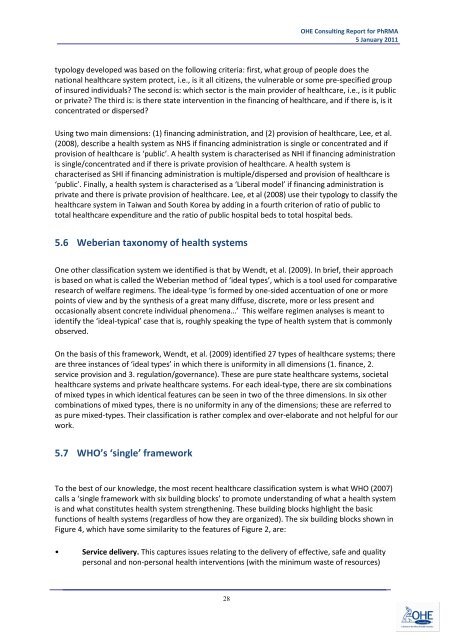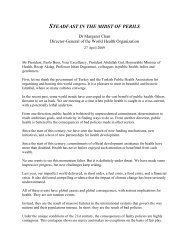The Evolution of HTA in Emerging Markets Health-Care ... - TREE
The Evolution of HTA in Emerging Markets Health-Care ... - TREE
The Evolution of HTA in Emerging Markets Health-Care ... - TREE
Create successful ePaper yourself
Turn your PDF publications into a flip-book with our unique Google optimized e-Paper software.
OHE Consult<strong>in</strong>g Report for PhRMA<br />
5 January 2011<br />
typology developed was based on the follow<strong>in</strong>g criteria: first, what group <strong>of</strong> people does the<br />
national healthcare system protect, i.e., is it all citizens, the vulnerable or some pre-‐specified group<br />
<strong>of</strong> <strong>in</strong>sured <strong>in</strong>dividuals? <strong>The</strong> second is: which sector is the ma<strong>in</strong> provider <strong>of</strong> healthcare, i.e., is it public<br />
or private? <strong>The</strong> third is: is there state <strong>in</strong>tervention <strong>in</strong> the f<strong>in</strong>anc<strong>in</strong>g <strong>of</strong> healthcare, and if there is, is it<br />
concentrated or dispersed?<br />
Us<strong>in</strong>g two ma<strong>in</strong> dimensions: (1) f<strong>in</strong>anc<strong>in</strong>g adm<strong>in</strong>istration, and (2) provision <strong>of</strong> healthcare, Lee, et al.<br />
(2008), describe a health system as NHS if f<strong>in</strong>anc<strong>in</strong>g adm<strong>in</strong>istration is s<strong>in</strong>gle or concentrated and if<br />
provision <strong>of</strong> healthcare is ‘public’. A health system is characterised as NHI if f<strong>in</strong>anc<strong>in</strong>g adm<strong>in</strong>istration<br />
is s<strong>in</strong>gle/concentrated and if there is private provision <strong>of</strong> healthcare. A health system is<br />
characterised as SHI if f<strong>in</strong>anc<strong>in</strong>g adm<strong>in</strong>istration is multiple/dispersed and provision <strong>of</strong> healthcare is<br />
‘public’. F<strong>in</strong>ally, a health system is characterised as a ‘Liberal model’ if f<strong>in</strong>anc<strong>in</strong>g adm<strong>in</strong>istration is<br />
private and there is private provision <strong>of</strong> healthcare. Lee, et al (2008) use their typology to classify the<br />
healthcare system <strong>in</strong> Taiwan and South Korea by add<strong>in</strong>g <strong>in</strong> a fourth criterion <strong>of</strong> ratio <strong>of</strong> public to<br />
total healthcare expenditure and the ratio <strong>of</strong> public hospital beds to total hospital beds.<br />
5.6 Weberian taxonomy <strong>of</strong> health systems<br />
One other classification system we identified is that by Wendt, et al. (2009). In brief, their approach<br />
is based on what is called the Weberian method <strong>of</strong> ‘ideal types’, which is a tool used for comparative<br />
research <strong>of</strong> welfare regimens. <strong>The</strong> ideal-‐type ‘is formed by one-‐sided accentuation <strong>of</strong> one or more<br />
po<strong>in</strong>ts <strong>of</strong> view and by the synthesis <strong>of</strong> a great many diffuse, discrete, more or less present and<br />
occasionally absent concrete <strong>in</strong>dividual phenomena…’ This welfare regimen analyses is meant to<br />
identify the ‘ideal-‐typical’ case that is, roughly speak<strong>in</strong>g the type <strong>of</strong> health system that is commonly<br />
observed.<br />
On the basis <strong>of</strong> this framework, Wendt, et al. (2009) identified 27 types <strong>of</strong> healthcare systems; there<br />
are three <strong>in</strong>stances <strong>of</strong> ‘ideal types’ <strong>in</strong> which there is uniformity <strong>in</strong> all dimensions (1. f<strong>in</strong>ance, 2.<br />
service provision and 3. regulation/governance). <strong>The</strong>se are pure state healthcare systems, societal<br />
healthcare systems and private healthcare systems. For each ideal-‐type, there are six comb<strong>in</strong>ations<br />
<strong>of</strong> mixed types <strong>in</strong> which identical features can be seen <strong>in</strong> two <strong>of</strong> the three dimensions. In six other<br />
comb<strong>in</strong>ations <strong>of</strong> mixed types, there is no uniformity <strong>in</strong> any <strong>of</strong> the dimensions; these are referred to<br />
as pure mixed-‐types. <strong>The</strong>ir classification is rather complex and over-‐elaborate and not helpful for our<br />
work.<br />
5.7 WHO’s ‘s<strong>in</strong>gle’ framework<br />
To the best <strong>of</strong> our knowledge, the most recent healthcare classification system is what WHO (2007)<br />
calls a ‘s<strong>in</strong>gle framework with six build<strong>in</strong>g blocks’ to promote understand<strong>in</strong>g <strong>of</strong> what a health system<br />
is and what constitutes health system strengthen<strong>in</strong>g. <strong>The</strong>se build<strong>in</strong>g blocks highlight the basic<br />
functions <strong>of</strong> health systems (regardless <strong>of</strong> how they are organized). <strong>The</strong> six build<strong>in</strong>g blocks shown <strong>in</strong><br />
Figure 4, which have some similarity to the features <strong>of</strong> Figure 2, are:<br />
<br />
Service delivery. This captures issues relat<strong>in</strong>g to the delivery <strong>of</strong> effective, safe and quality<br />
personal and non-‐personal health <strong>in</strong>terventions (with the m<strong>in</strong>imum waste <strong>of</strong> resources)<br />
28








